Relaterede emner
- Troubleshooting - Device Boot Failure or No Display After Boot (Black Screen)
- Laptop Frequently Asked Question (FAQ)
- [Windows 11/10] Troubleshooting - System is running slowly
- [Windows 11/10] Troubleshooting - Blue Screen Errors in Windows (BSOD)
- [Windows 11/10] Troubleshooting - Automatic Shutdown/Restart Issues
[Windows 11/10] Troubleshooting - Resolving System Error Messages or Unresponsiveness (Freeze/Black Screen/White Screen during usage)
Applicable Products: Notebook, Desktop, All-in-One PC, Gaming handheld, Motherboard, Graphic Card, MiniPC
If you encounter error messages or a lack of response from your device's Windows operating system, preventing any further actions (such as sudden system crashes, freezes, black screens, or white screens) during usage, please refer to the troubleshooting steps outlined in this article.
Note: If the screen is unresponsive and you cannot perform any actions, please attempt a forced shutdown. Press and hold the power button until the power light turns off to shut down the device. After restarting the device, follow the troubleshooting steps below to prevent the issue from recurring.
If the device crashes and a blue screen error is displayed, please refer to Troubleshooting - How to fix Blue Screen Errors in Windows (BSOD).
Table of Contents:
Remove accessories and Update BIOS / Windows packages / drivers to the latest version
- Disconnect all external devices, including the keyboard, mouse, external hard drive, printer, memory cards, CDs in the optical drive, and any adapter cards in card readers. Sometimes, external devices might cause your system to malfunction.
Note: Also, disconnect all external displays. If it's a desktop computer, start with one external display to verify that your computer can boot and display properly. - Regularly updating BIOS, Windows, and drivers can enhance system stability and performance. Ensure that your device is using the latest versions. Learn more about updating BIOS:
How to update the BIOS version in Windows system
How to use EZ Flash to update the BIOS version
(For desktop products, please refer to ASUS Motherboard EZ Flash 3 Introduction.)
Learn more about updating Windows and drivers:
How to execute Windows Update
How to update drivers via System Update in MyASUS
If the problem persists after you have updated BIOS/Windows packages/drivers to the date, please continue to the next chapter for troubleshooting.
System diagnosis for Hardware check
- Execute MyASUS system diagnosis for Hardware check, here you can learn more about MyASUS System Diagnosis.
If there is no System Diagnosis tab in MyASUS that means your device does not support this function. Here you can learn more about Why can I only see the partial features in the MyASUS app. - When temperatures inside the device is higher, it will reduce the system performance, learn more about Troubleshooting - Overheating and Fan issues.
The problems occurred after installing or updating software (Including drivers, applications, or Windows updates)
If the problem occurred after installing or updating software, try to remove or roll back to previous version. Here you can learn more about How to uninstall Apps, Windows installed updates, Drivers.
How to roll back to previously installed drivers through Device Manager:
- Right-click the [Start menu] icon①, then click [Device Manager]②. (The left-side illustration below is in Windows 11, and the right-side is Windows 10.)
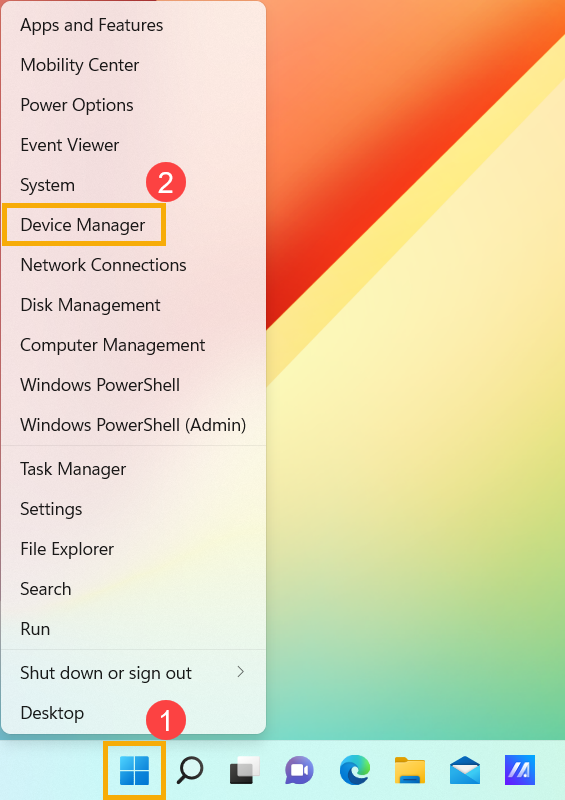
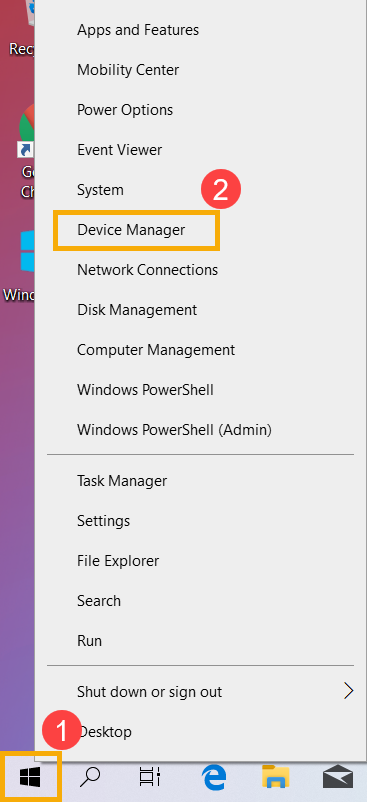
- Check the arrow next to [Display adapters]③, then right-click [Intel(R) UHD Graphics 620]④ and select [Properties]⑤.
The following steps are used Intel graphics as an example, please select the defective driver which you would like to roll back to the previous version.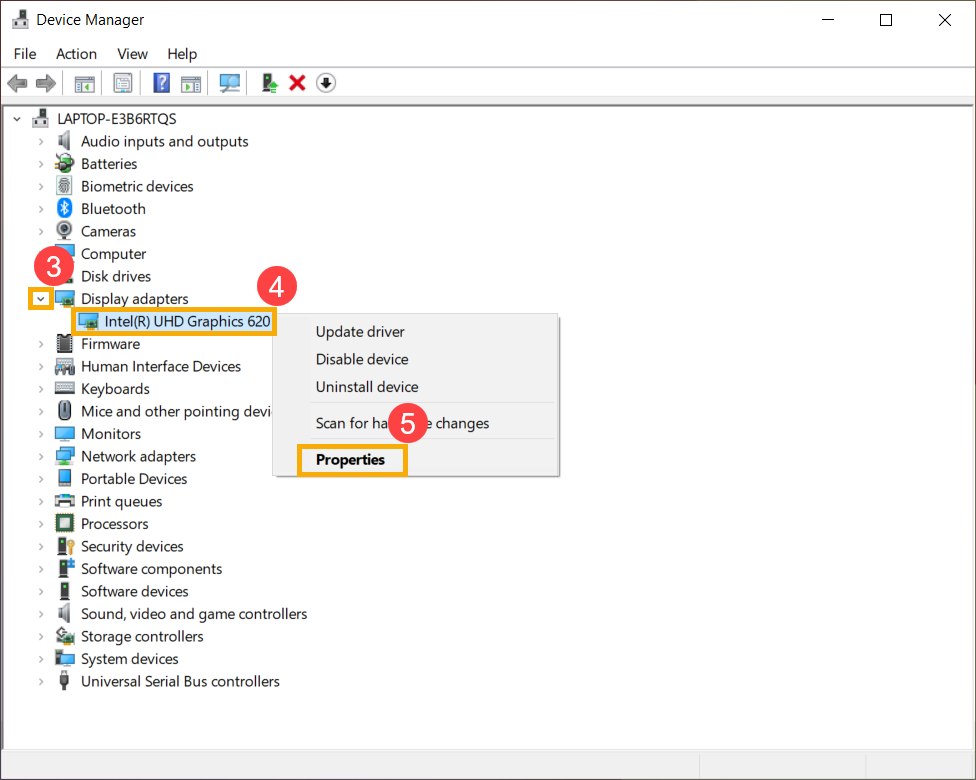
- Select [Driver]⑥, then select [Roll Back Driver]⑦.
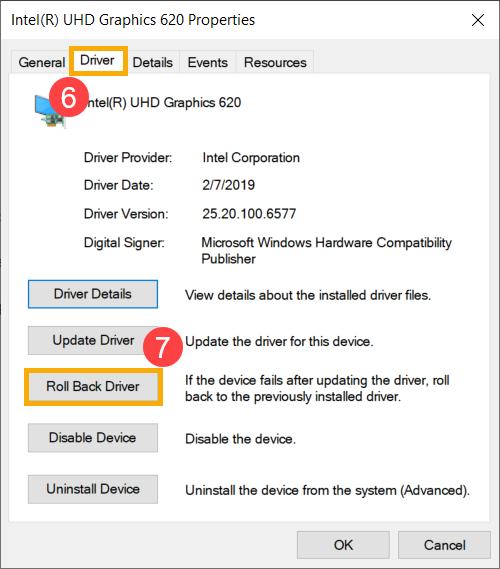
- Select the reason of [Why are you rolling back?]⑧, then click [Yes]⑨. The system will start rolling back to the previously installed driver.
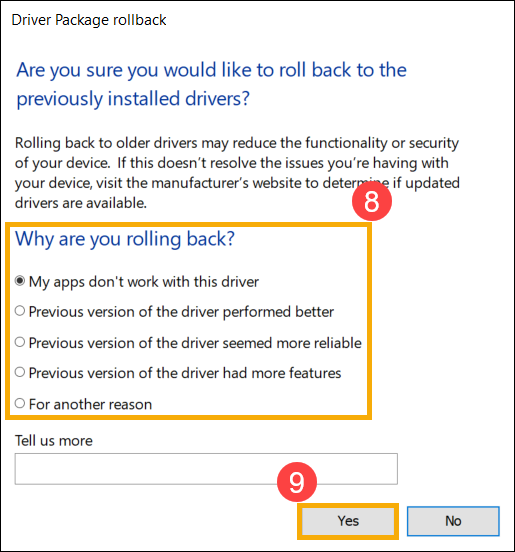
Improve Windows performance
Refer to the suggestions of Microsoft to check and setup in Windows, learn more about Tips to improve PC performance in Windows.
Restore the system from restore point
If the problem happens recently, and if you have ever created a restore point or there is an automatic system restore existed, try to restore the device to a point before the problem began to resolve the problem. Here you can learn more about How to use restore point to restore the system.
If the problem persists, please continue to the next chapter for troubleshooting.
Reset the system
If the problem persists after all troubleshooting steps are completed. Please backup your personal files, then reset the device to back to its original configuration. Here you can learn more about How to reset the system.
If your issue remains unresolved, please contact ASUS Customer Service for further assistance.